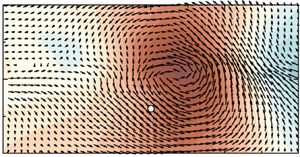Article contents
Dissimilar turbulent heat transfer enhancement by Kelvin–Helmholtz rollers over high-aspect-ratio longitudinal ribs
Published online by Cambridge University Press: 24 November 2022
Abstract

Passive heat transfer enhancement by spanwise rollers associated with the Kelvin–Helmholtz instability was studied through direct numerical simulations of high-aspect-ratio longitudinal ribs at the friction Reynolds number  $300$. The temperature was treated as a passive scalar with Prandtl number unity to discuss the similarity between the heat and momentum transfer. The results reveal that the high-aspect-ratio longitudinal ribs lead to a favourable breakdown of the Reynolds analogy, that is, the enhancement of the heat transfer rate surpasses that of the frictional resistance. The favourable breakdown of the Reynolds analogy can be attributed to the enhanced turbulent heat flux compared with the Reynolds shear stress, whereas the rib-induced secondary flow plays a role in reducing the favourable breakdown of the Reynolds analogy. The conditional average statistics reveal that the high-pressure region accompanied by the spanwise rollers suppresses the spanwise roller-induced sweep and ejection motions, leading to smaller Reynolds shear stress than for the turbulent heat flux.
$300$. The temperature was treated as a passive scalar with Prandtl number unity to discuss the similarity between the heat and momentum transfer. The results reveal that the high-aspect-ratio longitudinal ribs lead to a favourable breakdown of the Reynolds analogy, that is, the enhancement of the heat transfer rate surpasses that of the frictional resistance. The favourable breakdown of the Reynolds analogy can be attributed to the enhanced turbulent heat flux compared with the Reynolds shear stress, whereas the rib-induced secondary flow plays a role in reducing the favourable breakdown of the Reynolds analogy. The conditional average statistics reveal that the high-pressure region accompanied by the spanwise rollers suppresses the spanwise roller-induced sweep and ejection motions, leading to smaller Reynolds shear stress than for the turbulent heat flux.
Information
- Type
- JFM Papers
- Information
- Copyright
- © The Author(s), 2022. Published by Cambridge University Press
References
REFERENCES
- 11
- Cited by


